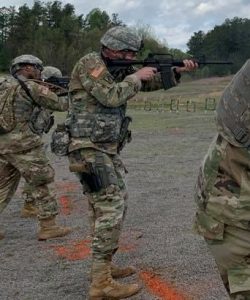
Tom Givens of Rangemaster and Jim Higginbotham of Riposte were our instructors, and were then, and are now, some of the very best in the nation at training the modern technique. It was eye opening how much that I learned in a two-day span, and with all candor, with the possible exception of the US Army War College, no training has impacted me more.
It is interesting to point out that this training was done with my unit in August of 2001, almost exactly a month before 9/11, when this nation found itself bracing for combat operations to prosecute the Global War on Terror. My unit of CD soldiers were the ones first in the Kentucky airports, as we had been trained; until a group of military policemen could be trained in it as well and relieved us. We then went back to normal CD missions. I exercised my training for the first time in March of 2003, on a meth surveillance mission in the western part of the state, and it was as clear to me then as it is now, that the Modern Technique works.
The same Commanding General that sent us to Rangemaster, knowing then what I do know, decided that all of the soldiers from Kentucky who deployed for GWOT would have this training. If one can prepare for such a thing, Kentuckians were- and the combat record for Kentuckians in Iraq and Afghanistan speaks for itself. (See Raven 42, March 2005; and Roberts Ridge, March 2002) I did report- formally and on the record – to the Center for Army Lessons Learned, that the modern technique/ close quarters combat training was the single most impactful and greatest preparation event necessary for combat effectiveness in Iraq and Afghanistan.
Simply, my argument was and is that the modern technique of weaponcraft is a marvelous thing for anyone that could be confronted in a situation which they would have to defend themselves with a firearm. Employment of the system that is reflexive, efficient, precise, and aggressive gives one a decided edge over a potential armed adversary.
As the value was understood, the demand for this training increased, as did the need for qualified instructors, and many schools of weaponcraft and pistol training sprang up within the decades that followed. Some of these are first rate outfits, and some not as much. Those that have validated their training through experience are those that I recommend if one needs to use a weapon professionally, or even possibly. Or is simply enthusiastic. If your instructor can only parrot what he has been taught from the single course that he has attended, he may too myopic to really make it worth your time.
Since the first Range Master course, I have had occasion to train with half a dozen outfits, as assignments domestically and internationally required it to be so. The basic tenor of the courses is overly positive- approaching 90%, proper and effective- and I would recommend them all for someone who seeks this level of competence and wishes to change themselves from enthusiastic to formidable.
The main difficulty that I have seen with a few courses being taught currently, is the evolution of how this training has conducted, that the modern technique from the Cooper days is no longer “modern”, and those additions and changes made to the basics of the modern technique can be good for most operators, but not all. Generally, these modifications are promoted as gospel, according to the prophet that taught the first course that the instructors have attended. I am guilty of this myself, as I consider Mr. Givens and Mr. Higginbotham’s course to be the finest that I have seen, and it certainly shaped my outlook to the stubborn. However, changing something because it seems like it is a good idea, adds movements to the schedule that must be mastered, may not fit those that are differently abled, and my contention is that it should be shaped to the capabilities and sensibilities of the individual operator.
For example, I am not fast with a pistol if I carry this arm on my belt, strong side, which I do the most often. I am not built for speed naturally, and I also have arms longer than average for a man my size and presenting the weapon from the holster on my belt makes me contort my arm into what looks like a chicken wing. Those schools that emphasize speed, well- I can’t do that. Knowing this, I must see to my own and make up for this lack of speed by being smart elsewhere. I believe that this is the proper method, to train an operator within themselves, and generate a solution that is the best for them. A one sized, fits all, approach this could be lost, and I consider that both impolite and damaging. “If you can’t, you are wrong.” I think it is not that much more difficult to find what works for the individual.
As such, the evolution, adding new things and requiring students to perform those tasks as absolutes, I do not consider wise. I see, and insist upon five absolutes, and the remainder of the drills should revolve around what best matches the shooter’s abilities or physicality. Four of those five absolutes are the universal safety rules, which I do not think can be improved upon. The fifth, is the notion that needs to be conveyed that the pistol is going to hit where the sights are pointed. The rest, up for grabs. Stance, grip, arms straight, arms bent, head up, head down, standing on your head, whatever- if it works for you to get to number 5, then it’s good. Sort of channeling Murphy’s law of combat number 6 “If it is stupid, but it works, it’s not stupid.”
The generating intention for this as a philosophy, is that the modern technique is not only about shooting a rifle/ pistol, but the manipulation of an entire system of defense. This system makes the pistol in the hand not a weapon, but simply a tool, as is the holster, belt, mag pouches, body armor, hands, arms, legs, body- all subordinate to the main weapon system, which is the squishy thing between one’s ears. It is developed to the point that one change to the system, like simply changing one’s belt- can influence the entire system and require operator adjustment. Likewise, changing weapons, holsters, strong side to appendix carry, etc.- these require the operator to modify his system manipulation to be productive and responsibility defensive.
The ultimate goal of training the modern technique is “reflexiveness”, or muscle memory which places the greatest portion of employment to the subconscious. This is smart- brilliant actually- as during a combative confrontation incident, your conscious is going to busy thinking about other, more important things. That is the point in time where you can’t be trying to remember where the safety on the firearm is, or if you can get it disengaged.
I think keeping the objective in mind is an important point. The milestones of training begin at safety, then marksmanship, then the system, and lastly the environment. This dictates that the instructor allows himself to morph from teacher, to coach, to a trainer we can know as a “caller” which is one simply exercising those that are trained and up to speed, as a personal trainer or Peloton instructor would. Reflexiveness, muscle memory, etc. is something that can be practiced by oneself, surely, but having a caller that announces different strings of fire with various numbers of rounds, etc. is important to the shooter that has essentially mastered the primary dance steps. Training as this, does not allow the shooter to anticipate, rather adjust to the situation called. This is something that is very valuable.
Responsible firearm ownership for defensive purposes requires that the weapon be handled safely, as a primary goal, but effectively when the situation calls for it. On this day, which is going to be one of the worst days of your life, one will not rise to the occasion as much as default to the lowest level of training. The modern technique, properly applied, will get you there.
https://www.nationalguard.mil/Resources/Image-Gallery/Historical-Paintings/Heritage-Series/Raven42/
Jim Higginbotham (24) Jim Higginbotham Dynamic Response Video – YouTube

